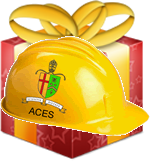
 Independent Study Projects. Please read our overview on why ACES pursue Independent Study Projects so vigorously. First off, as expressed in class, ISPs are a gift to you. You chose this course as an option and, in turn, the course rewards you with the reins to drive and explore your unique future. This opportunity is one of the few areas in your secondary school experience in which you gain significant course credit for dozens of hours of commitment and engagement in pursuit of an outcome you have (almost) complete control over. In doing so, wise ACES welcome the opportunity to affirm their interest and passion for pursuing a post-secondary engineering degree in an area that appeals to them. ACES grads make better program and university choices in Grade 12 as a direct consequence of their ISP efforts. So, research and select the focus of your efforts as carefully and throughly as possible so all the effort will be both enjoyable and deliver the most meaningful outcomes.
Independent Study Projects. Please read our overview on why ACES pursue Independent Study Projects so vigorously. First off, as expressed in class, ISPs are a gift to you. You chose this course as an option and, in turn, the course rewards you with the reins to drive and explore your unique future. This opportunity is one of the few areas in your secondary school experience in which you gain significant course credit for dozens of hours of commitment and engagement in pursuit of an outcome you have (almost) complete control over. In doing so, wise ACES welcome the opportunity to affirm their interest and passion for pursuing a post-secondary engineering degree in an area that appeals to them. ACES grads make better program and university choices in Grade 12 as a direct consequence of their ISP efforts. So, research and select the focus of your efforts as carefully and throughly as possible so all the effort will be both enjoyable and deliver the most meaningful outcomes.
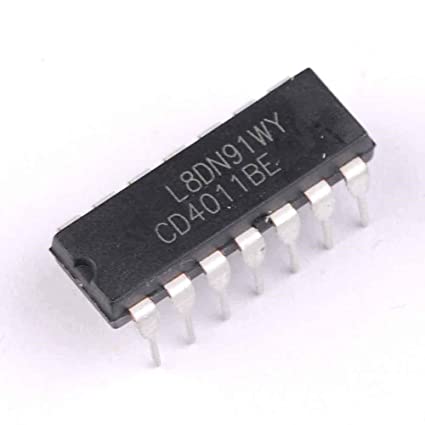 The desire to Wow! your peers with your technical wizardry is a compelling temptation. The internet is full of projects with an off-the-chart cool factor as evidence of the human desire to impress. Furthermore, all the parts come in these kits with a step-by-step assembly guide and instructable. Bingo! for less than $20 and 2 hours, your ISP is in the bag. Yes, that's one route you could go. On the other hand, I suggest going the other way: low-tech. Logic gates (AND, OR, NAND, NOR, XOR, XNOR, NOT, etc.) provide many of the building blocks that support digital electronics. There are 1000s(?) of interesting circuits built using these gates. One of which would be a 14-segment decoder circuit. You used the 7-segment decoder in Grade 10 (4511) and were introduced to the 14-segment display in your PoV assignment. Hmmmm....Here's another one... You know by now how critical clock signals are in digital electronics. In your kit you have all the necessary parts for a Crystal (Pierce) Oscillator. Hmmm....
The desire to Wow! your peers with your technical wizardry is a compelling temptation. The internet is full of projects with an off-the-chart cool factor as evidence of the human desire to impress. Furthermore, all the parts come in these kits with a step-by-step assembly guide and instructable. Bingo! for less than $20 and 2 hours, your ISP is in the bag. Yes, that's one route you could go. On the other hand, I suggest going the other way: low-tech. Logic gates (AND, OR, NAND, NOR, XOR, XNOR, NOT, etc.) provide many of the building blocks that support digital electronics. There are 1000s(?) of interesting circuits built using these gates. One of which would be a 14-segment decoder circuit. You used the 7-segment decoder in Grade 10 (4511) and were introduced to the 14-segment display in your PoV assignment. Hmmmm....Here's another one... You know by now how critical clock signals are in digital electronics. In your kit you have all the necessary parts for a Crystal (Pierce) Oscillator. Hmmm....
To my mind, the characteristics of a great project include such aspects as imagination, creativity, a degree of risk and, sometimes, even simplicity, to name a few. Your goal should be to place yourself on a journey with as steep an upward trajectory that your level of calculated risk will tolerate. In this way, you will learn a great deal about yourself and broaden your skill set at the same time. Check out the flashlight circuit 'board' this guy made out of little more that a piece of paper and a pencil? Simple, but inspiring.
Consider a problem that needs a solutions. Boyan Slat did at age 17 when he was in high school; four years later he is  cleaning up the world's oceans. So, dig in, think, dream, research, and explore possible project pursuits. Be discerning: don't commit to the first project that comes along. Have your phone handy to at all times to capture the images of your journey. Be conscious of the fact that a multi-page summary of your project will appear in your DER after Presentation Day for more permanent record of your efforts. You may wish to take into account the ISP Evaluation document that will be applied on your Presentation Day.
cleaning up the world's oceans. So, dig in, think, dream, research, and explore possible project pursuits. Be discerning: don't commit to the first project that comes along. Have your phone handy to at all times to capture the images of your journey. Be conscious of the fact that a multi-page summary of your project will appear in your DER after Presentation Day for more permanent record of your efforts. You may wish to take into account the ISP Evaluation document that will be applied on your Presentation Day.
Also, don't underestimate the value of an enterprise/entrepreneurial aspect to your project that could see a number of units of your project for sale in the Dragon's Lair or beyond, reaching an even a broader audience.
ISP Logs
| D. Anderson |
 GuitarTuner GuitarTuner
The purpose and description of my ISP is for me to build and program a working guitar tuner using an Arduino uno and many more components such as LEDs and resistors. The guitar tuning itself is conveyed by the LEDs and by having a few of the LEDs for if the note is sharp or flat when played and then a line of other LEDs indicating the exact note you are playing to give the most accurate tune.
MCU:: 328P (UNO)
PCB: Stripboard
CAD: 3D Printed Case
|
 Controllable Robotic Arm Controllable Robotic Arm
The controllable robotic arm project is a direct relation to the inspiring Tony Stark Dum-E robotic arm that would help Tony around his workshop. This robotic arm uses rotary potentiometers to control the different directions of motion for the different components of this arm. Through the uses of eagle and fusion this project will demonstrate a compact design while maintaining a strong base to uphold the hand size robotic arm. This project will have a claw with the ability to clasp using a button and as well have two major structures to the arm that feature all movements of north, south, east, and west directions of rotations.
MCU: 328P
DESIGN: Through the use of eagle, a small custom PCB will be configured to maintain a compact state for this project. The use of fusion will be much needed to cover the motors connecting to the PCB and other exposed parts that are an eye sore. Stranded wires from the PCB may be needed to the motors but the 3D print will cover those problems. The 3D print will be printed in sections and snapped together in parts because of the desired ability to open the case when needed which aids for the building process and for the eventual demonstration of this arm.
COMMUNICATION: No communication is needed in this circuit but if time is in abundance, the ability to make a remote as opposed to mounted potentiometers on the case. This would give the ability to control the circuit from a distance which would be much better but that is a project in itself and time is a luxury in this extensive project.
MECHANICAL: Servo motors will most likely be used in this project which will connect to the atmega328P used in this circuit and will be controlled by the actions on the potentiometers. These potentiometers will be mounted on the 3D print for the user and the actions will be made within the case. |
| S. Appleyard |
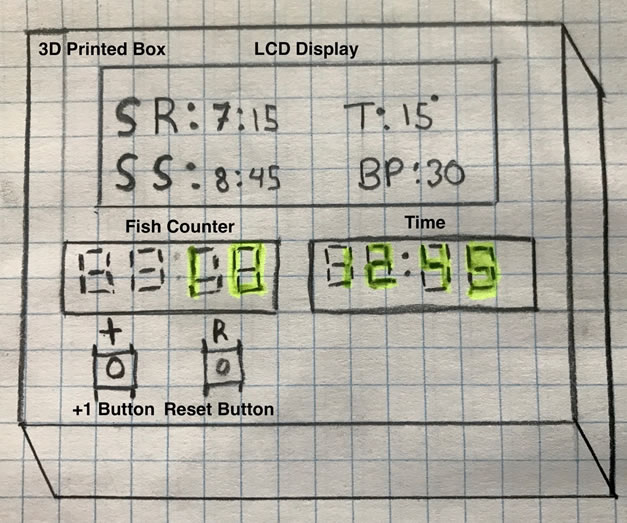 A Fish Counter Weather Station A Fish Counter Weather Station
This project will display sun rise and sunset as well as temperature and barometric pressure on an LCD display. On a separate 4 digit 7 segment display it will display a clock with hours and minutes and on one final 4 digit 7 segment display it will display the number of fish caught. To increase the number, there will be a button that you can press. Every time the button is pressed the number will rise by one. There will also be a reset button for the fish counter.
MCU: 328P (Nano)
PCB: Stripboard + Acrylic
CAD: 3D Printed Case
|
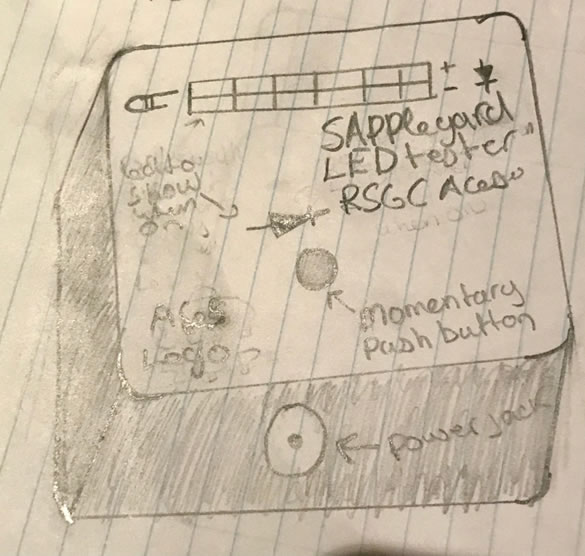 LED Tester LED Tester
This project will consist of a simple LED tester mounted in a 3D printed case probably made of resin with a PCB for the circuit and an acrylic top. There will be a push button that when pressed will illuminate a test LED and give power to rails at the top with different resistance levels for testing the LEDs. The final product will hopefully be handed out to future grade ten students replacing the current LED tester found in every kit.. The challenge with this project will be making it so as little assembly as possible is required. Attention will also have to be paid to keeping it at a reasonable price. My goal for price is under $7 per unit.
MCU: None
PCB: JLCPCB
CAD: JLCPCB Resin print, clear acrylic top |
| T. Appleyard |
 Portable Time and Temperature Device Portable Time and Temperature Device
This will be a 3D printed circuit case that when turned on will tell you the exact time and temperature displayed on an 4-segment 7 segment display, and a dual 14 segment alphanumeric display.
MCU: 328P (Nano)
PCB: Stripboard
CAD: 3D Printed Case
|
 Watch Winder Watch Winder
When complete this device will wind/charge any analog windable watch. This will be a neat box that uses two servo motors to wind two watches. It will have two PCBs. The circuit will have two settings for variable speed.
MCU: UNO
PCB: EAGLE, PERMA-Proto
CAD: Acrylic, 3D Printing and Wood.
|
| F. Canavan |
 Air Quality Monitor Air Quality Monitor
The air quality monitor is a monitor that detects and monitors the air quality in the room using an MQ135 air quality sensor. It also measures the room temperature and humidity using a DHT11 and shows the data on a 16x2 LCD Display.
MCU: 328P (UNO)
PCB: Not specified
CAD: Not specified
|
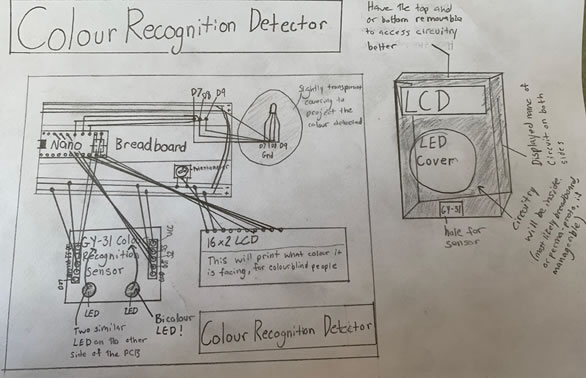 Colour Recognition Detector Colour Recognition Detector
The Colour Recognition Detector project consists of a simple yet sleek 3D design with separate compartments for each of the three main components used in the circuit. The GY-31 Colour Recognition Sensor uses passive colour recognition, meaning it goes straight to the RGB LED, and active colour recognition, meaning it is an active recognition which is processed by the Arduino Nano to output a specific colour. The RGB LED will have a slightly transparent covering over it, so it will project the colour detected by the GY-31, which will make it much easier to see the colour detected. The circuit will only be able to detect certain common colours like Red, Green, Blue, Black, and White, with the possible addition of a few other uncommon colours along the way, as the GY-31 can detect any colour, regardless of the lighting or time of day. The overall circuit will be a fairly compact design as there is not a plethora of components used, but the overall idea is more creative than the complexity of the circuitry.
MCU: Nano
PCB: Not specified
CAD: Fusion 360 |
| A. Deckha |
 Digital Alarm Clock Digital Alarm Clock
This Digital Alarm Clock is a system that I will hopefully emulate its widespread manufactured model. I will be attempting to create a product that will digitally display the time (with AM and PM), along with a programmable alarm clock, attached to a buzzer. The display will be powered by a RTC, in order to keep an accurate time, and will be using I2C for this to function efficiently. The setting of the alarm should consist of a system powered by PBNO buttons, in which, the user will press them to set the alarm. Essentially, this system should ideally reciprocate what a normal household appliance alarm clock performs.
MCU:: 328P (UNO)
PCB: Not Specified
CAD:: 3D Printed Case (Fusion)
|
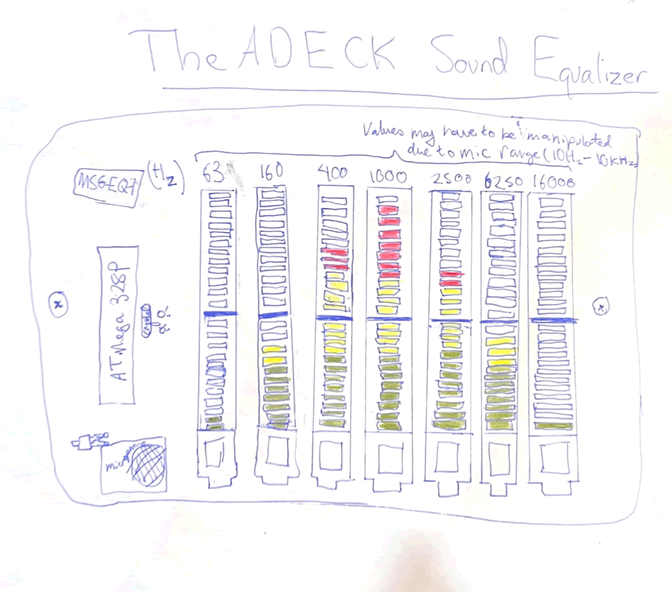 ADECK Sound Equalizer ADECK Sound Equalizer
The ADECK Sound Equalizer will be a very similar to a graphic equalizer that could have been frequently be seen in the music industry. First, I will be using an audio in component using an electret microphone that has the ability to detect sound input. Then, I will be utilizing an MSGEQ7 chip that has the ability to divide the audio spectrum into seven bands, represented by different peak frequencies. These frequencies are 63 Hz, 160 Hz, 400 Hz, 1 kHz, 2.5 kHz, 6.25 kHz and 16 kHz. This chip also has the ability to multiplex these “peak detects” into an output. Then, it can provide a value of the output to provide a DC representation of the amplitude of each band. These 7 bands’ output value will then be visually displayed on 7 I2C 24 LED bicolor bar-graphs.
MCU:: 328P (UNO)
PCB: I hope to put my skills to the test and utilize both eagle and Fusion
CAD: The 3-D printed case will primarily act as a base, to display the PCB design.
|
| A. Elder |
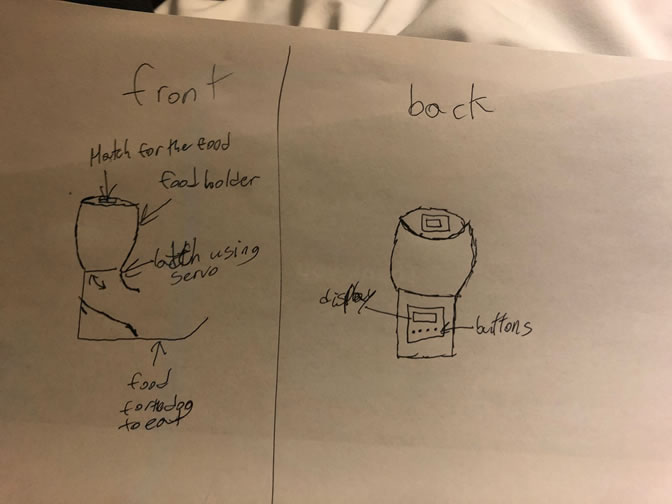 Auto Dog Feeder Auto Dog Feeder
The Auto Dog Feeder the Auto Dog Feeder Will use a DS1307RTC to keep track of time. The main processor will be the ATMEGA238p. It uses two motors for opening and closing the food hatch. You can control the time when the food is dropped by changing the time shown on the control box at the back. This control box will consist of a display showing the time that it will drop the food at and have 2 buttons to change the hours and minutes it drops at. You will also be able to add a certain number of meals a day by another button on the back. The design will be 3D-printed with a rechargeable battery for longer use. MCU: 328P (UNO)
PCB: Point-to-point
CAD:: 3D Printed Case
MECHANICAL: Servo
(PWM)
|
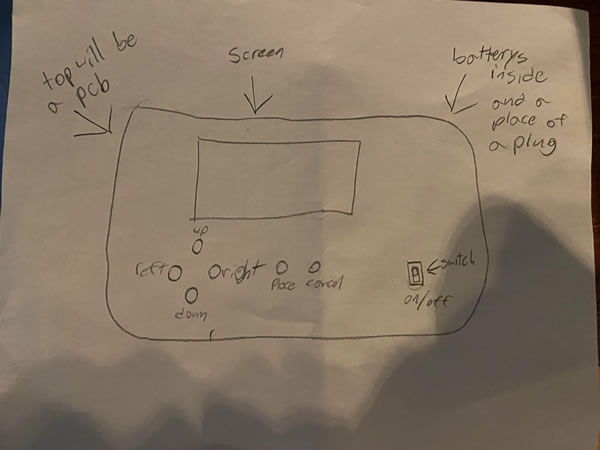 The Game Box The Game Box
You will be able to play games that will be displayed on the motor and can uses the buttons below the screen to the chosen game. There will be built-in battery’s so you can play where ever there will be up, down, left, right, place, cancel, and on/off. All these pieces will be on a PCB.
MCU:: 328P
DESIGN: I will use a PCB from eagle and will make a case for the PCB to attach to and to the parts into a case.
COMMUNICATION: I will use I2C communication to transfer the data.
|
| T. Landon |
 Tachometer with I2C OLED Display Tachometer with I2C OLED Display
I will be building a tachometer which calculates and displays the revolutions per minute (RPM) of the crankshaft of a vehicle’s engine. The final product will have a 3D printed case and uses IR sensors. This version will not be mounted to my dirt bike due to the fact that I am not a mechanic so, to show that it works, I will be using a bike tire to show that my project can count the RPM.
MCU:: 328
PCB: Not indicated
CAD:: 3D printed Case (Fusion 360)
|
 Alarm Clock with Lights as an Alarm Alarm Clock with Lights as an Alarm
I will be making an alarm clock that lights up multiple LEDs in order to light up a dark room in the morning. This way, it will be easier to get out of bed. It will have a 3D printed case and most of the parts used will be included in our kit.
MCU: 328P
PCB: Not sure...
CAD: 3D printed Case (Fusion 360)
|
| H. Mann Shaw |
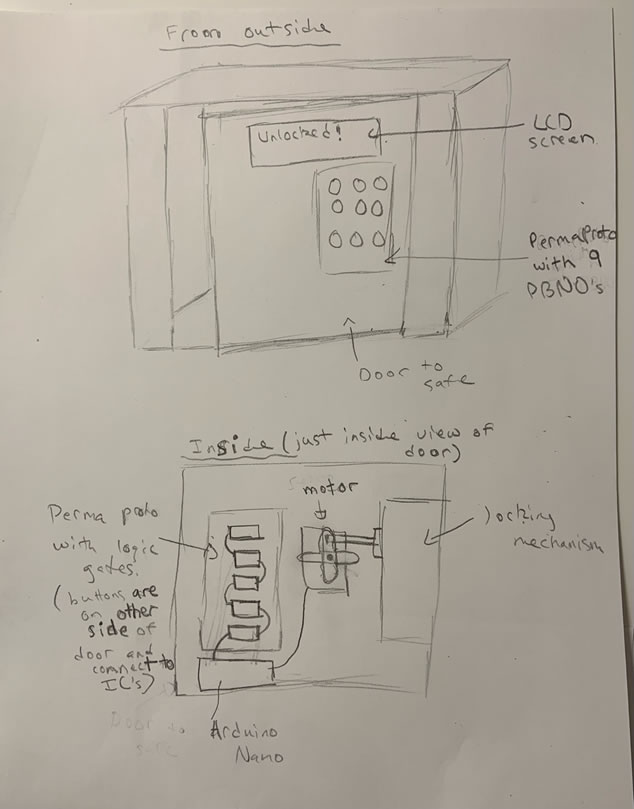 Home Alone Inspired Mini Circuit Safe Home Alone Inspired Mini Circuit Safe
The general idea of this project is a mini, electronic, mechanical safe. The safe will be opened by a passcode entered through 6 push buttons, with an additional 3 others, to reset what you typed, to open the safe, and to close the safe. This will work through the use of a configuration of logic gates, ultimately making it so that a high is only ever delivered if the right code is entered. This high signal will then be sent to an Arduino Nano so that the Nano can send out instructions to a motor, to make it rotate. This rotation will open a wooden locking mechanism, allowing for the user to open the safe. An LCD screen will also be used to alert the user when the safe is locked or unlocked.
MCU: 328P (Nano)
PCB: Perma-Proto
CAD: Wood & Glue
COMMUNICATION: Serial
MECHANICAL: Servo
|
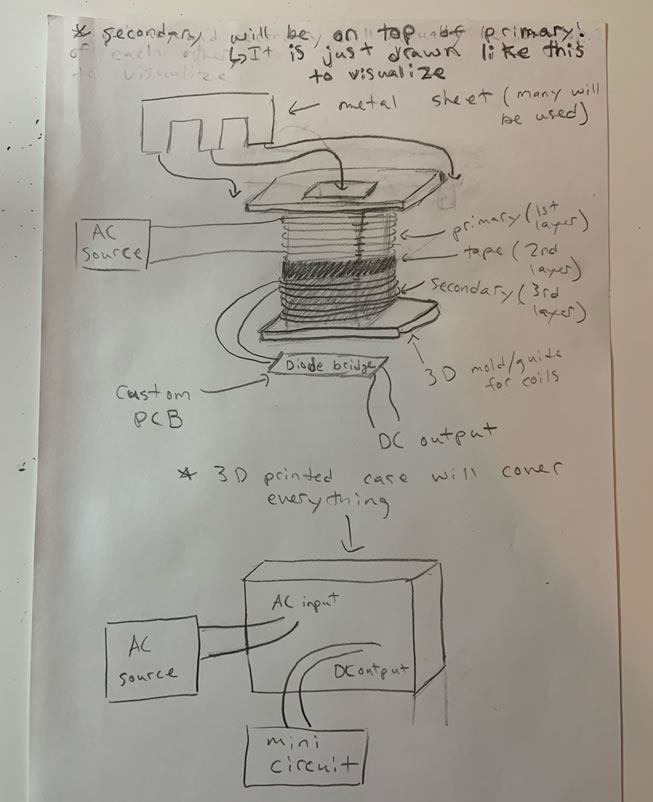 AC to DC Power Source AC to DC Power Source
For this project I plan on building a step-down AC voltage transformer along with a diode bridge to convert AC to DC. The transformer will be made of iron sheets with coils of copper wire to create the secondary and primary of the transformer. These coils will be separated with electrical tape and will be guided with a 3-D printed base. The output AC of the secondary coil will then tie into a diode bridge made with diodes, resistors and capacitors on a custom PCB. The output DC will then power a small circuit. I also plan on doing all of the math for this project so that I have a really good understanding of the underlying mechanisms.
MCU: None
COMMUNICATION: None
MECHANICAL: No motors are required for this project and the only mechanical-ish part of the project is the coils of copper wire to create the transformer.
DESIGN: I plan on 3-D printing a mold/form for the transformer which allows for the coils to be neat and for iron sheets to fit inside. Additionally, I will design a 3-D printed case which will hold the rectifier as well as the transformer. The rectifier circuit will be on a custom PCB from JLC which I will design.
|
| R. Muir |
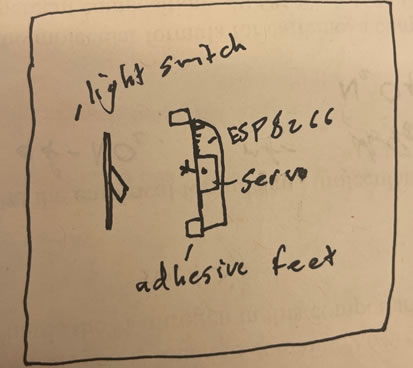 Modular-Mechanical Light Switch Controller Modular-Mechanical Light Switch Controller
is a device that can be placed on any light switch and enables the user to turn on and off the light switch via Wi-Fi communication. The design will be universal to all light switches, and even future 3D printed adapters for other types of switches and slides that exist. MCU:: ESP8266 (Wi-Fi)
PCB: CUSTOM (EAGLE)
CAD::
EAGLE
MECHANICAL: Servo (PWM)
|
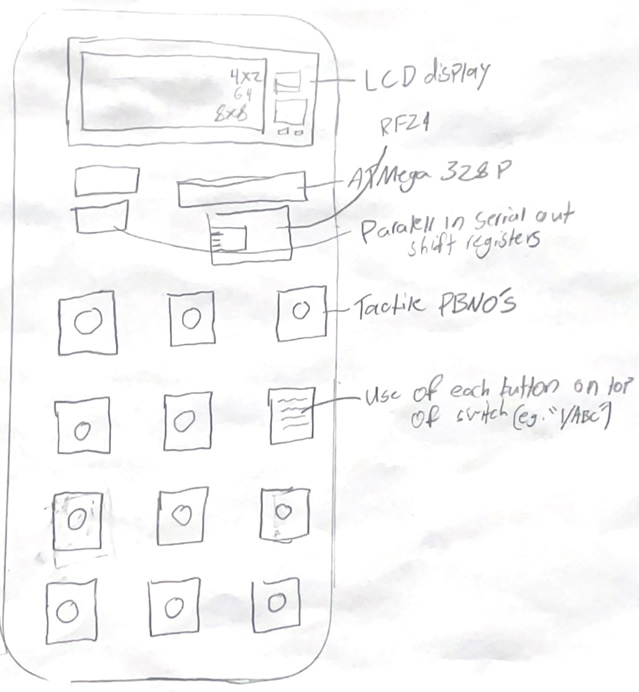 Muir Cheating Calculator Muir Cheating Calculator
A fully functioning calculator that under the hood uses a RF24 radio transmitter to be able to communicate with a computer, which makes googling questions possible.
MCU: ATmega328P
DESIGN EAGLE,
Fusion360,
3D Printing
MECHANICAL: None
COMMUNICATION: RF & Wi-Fi
|
| J. Rogan |
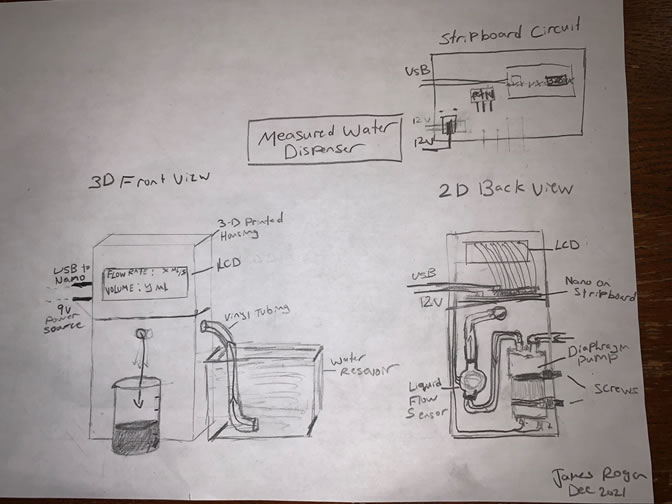 Measured Water Dispenser Measured Water Dispenser
The measured water dispenser asks for user input from the Arduino Serial Monitor and dispenses the inputted value's equivalent in mL of water. When there is an input, a diaphragm pump draws water from a reservoir through a liquid flow sensor and out of an open end of the vinyl tubing. The volume of water and flow rate are displayed on an LCD. The liquid flow sensor and pump are powered with a 12V power source and controlled using an Arduino Nano and a supporting MOSFET switching circuit on stripboard. The electronic and mechanical components are in separate 3D printed housing modules to reduce the risk of water damage.
MCU: 328P (Nano)
PCB: Stripboard
CAD:: 3D Printed Modules
COMMUNICATION: Serial
MECHANICAL: Diaphragm Pump (+ Liquid flow sensor) |
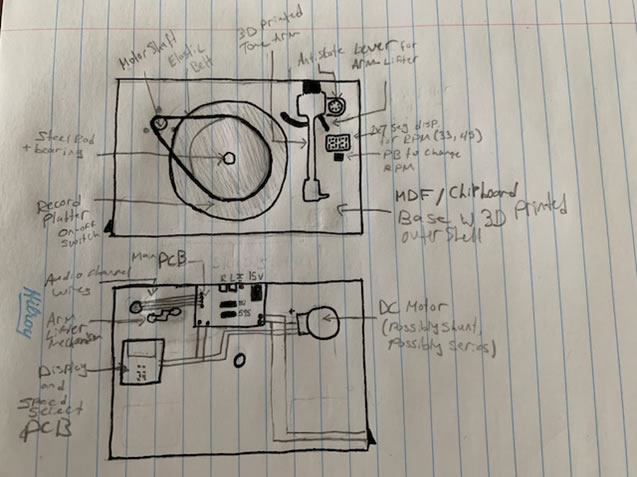 Rogan Record Player Rogan Record Player
The Rogan Record Player will include a belt-driven turntable, a 3D printed tone arm with two pivot points, a spring-loaded mechanical cue lever, a speed-select button for 33 and 45 rpm, and a dual 7 segment display to show the speed. The tone arm will have a built-in holder for a moving-magnet cartridge, a hollow shaft to pass audio channel wires, and an anti-skate spring mechanism. The motor will be a DC Series motor with a field diverter as speed control. The speed-select PCB will act as a two-setting rheostat for motor speed control, with the perfect resistance to achieve the two desired speeds. The record platter will be made of cast aluminum alloy and will sit on a steel rod and bearing to spin smoothly. An ATtiny85 and a 595 will control the POV display. The circuitry will require 15V DC to function as imagined.
MCU: ATtiny85
DESIGN EAGLE,
Fusion360,
3D Printing,
MDF Board
MECHANICAL: Series DC Motor with Field Diverter
COMMUNICATION: SPI |
| E. Shea |
 Arduino SONAR Arduino SONAR
The Arduino Sonar will be a build that is able to scan an area in a 110-degree radius detecting if there is an object and reporting it back to a custom-made graphic that will display red lines where an object is seen and green where it does not spot an object.
MCU:: 328P (UNO)
PCB Stripboard
CAD:: Not Specified
COMMUNICATION: Serial
MECHANICAL: Servo (+ Acrylic Mount)
|
 Wireless Controller Wireless Controller
The wireless controller will be a controller that controls a video game displayed on a computer using processing. The controller will utilize the HC-05 Bluetooth transceiver along with a standalone ATmega 328p. It will come in a 3d printed case and will have a custom PCB inside the case. The inputs for this controller will be both buttons and two dual axis joysticks.
MCU:328P
DESIGN This build will have a custom PCB created on eagle and created by JLCPCB. This build will also include a 3d printed case created on fusion360.
COMMUNICATION: This build will communicate with the computer through Bluetooth using the bluetooth serial port of the computer |
| J. Strain |
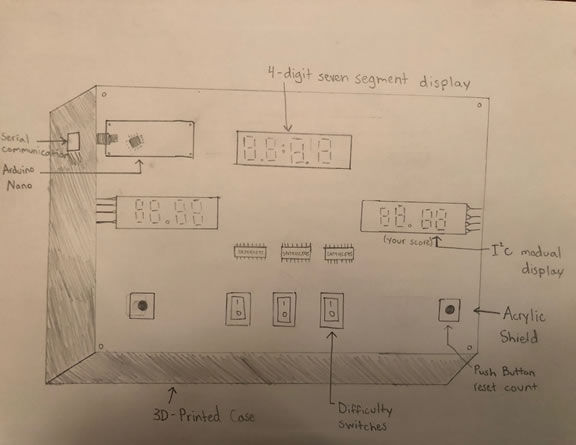 Guess the Operator Guess the Operator
Guess the mathematical operator is a two-person game that requires the user to guess the operation that transforms an input into the output. An input output table will be displayed on the serial monitor and an external timer will define how many points the user will get for answering correctly. After the first user presses the button the time resets and a new set of inputs and outputs in displayed for player two. The user has control over which numbers he would like to input to identify the output. A total of three difficulties will modify the point count and will include harder operators which include bitwise AND, OR, XOR, and more as well as bit shifting, conversions and base transformations. This project will use the DS1307 for the stop watch and will include switches to determine difficulty. Shift registers are used to shift score totals out to the I2C display module. The TC74 might be included to read the data to guess Celsius to Fahrenheit conversions. Equations for to calculate voltage, current and resistance may also be added. The game finishes when a player reaches a certain number of points.
MCU: 328P (Nano)
PCB: Stripboard
CAD: 3D Printed Case + Acrylic
|
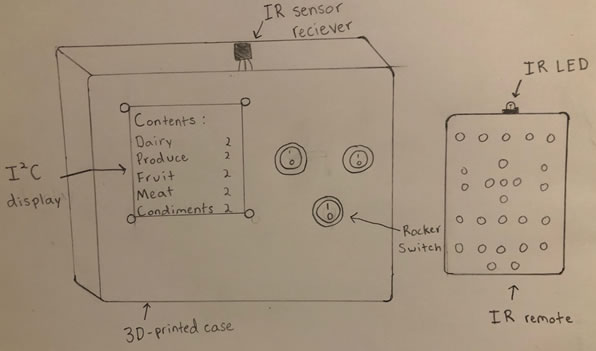 The Automated Fridge Content System The Automated Fridge Content System
The Automated Fridge Content System is made for everybody who aims to simplify the rigorous task of grocery shopping. If there have been occasions where too much food was purchased this could all be avoided. This system is updated using an infrared remote and sensor receiver. Each button determines which product is selected to update to the OLED I2C display. Products are categorized by fruits, produce, condiments, dairy, meats, and juice. To view the individual contents of each category there will be 3 rocker switches. A 9V power source will provide sufficient voltage to this system and a 7805-voltage regulator is used to limit the voltage on the ATmega328P.
MCU: 328P
DESIGN: Both Fusion 360 and eagle will be incorporated for this project. A custom PCB will be used to support the display as well as communications such as IR, I2C, and SPI. Finally, a 3D printed case will encase the project to be viewed by family members specifically those who do the grocery shopping.
COMMUNICATION: There will be three forms of communication in this project including SPI, I2C and IR or infrared communication. The infrared communication in the form of a remote is used to determine which product is updated to the device. I2C is incorporated through the use of the I2C display module and SPI is included for the standalone 328P.
|
For the bulk of your formal education you have been, and will continue to be, required to consume curriculum chosen for you by someone else. Fortunately (hopefully) you will put this knowledge and skill to good use in your future.
However, jumping through someone else's hoops alone does not secure future success, satisfaction, happiness and mental stability. For that, you must continually demonstrate your own initiative, creativity, motivation, and passion. These qualities need to be continuously cultivated, recognized and respected and our Grade 10 hardware course is a perfect place to start. There is so much inspiring concepts to learn and there are so many great projects out there that offer stimulating contexts within which to develop, refine and define, your interests.
Parkway: This is a device that can be connected to a guitar to distort sound and change the loudness of it. CAD will be employed to design and print a case for the device.
Barkway: When the Netlfix Button on a remote is clicked, it turns on music, turns off the lights, and turns on dimmed lights. Will also include a designed platform to hold the circuits on a wall, and a connector between a servo motor and a stylus pen. Also turns on Netflix.
Design: 3D Printing
Communication: IR
Carson: A device that blocks electronics from receiving calls or Wi-Fi signals, housed in a custom 3D designed and printed case.
Carson: It will be a module that can be placed over a door handle so that you can open a door using your feet when your hands are full. It will also include a locking mechanism and an alarm that can be used remotely.
Design: 3D Printing
Communication: IR, BT
Dolgin: A 3D designed trash bin with placement tray. Once an ultrasonic sensor detects an object in the tray, it will lift the tray and place the contents in a larger reservoir. Another sensor is employed to monitor the available capacity of the bin and displays this result on a bargraph.
Dolgin: RF controlled two wheel rover design, able to turn right, left, travel forwards and backwards using a joystick or push buttons. Fusion will be used to design the body, case, and eagle will be used to design the PCB remote
Design: EAGLE PCB, 3D Print
Communication: RF, possibly IR
Dreger: This device employs a wireless keypad for activation/deactivation. The clock housing and remote case will be designed in CAD and printed.
Dreger: I will create two devices that use a GPS module to get the position then send that position, via a SIM card module to a phone or on the other device it will send the position to another Arduino with an LCD Screen via an nRF
Design: EAGLE PCB, 3D Print
Communication: RF
Fatola: Players have to match numbers on 2 7-segment displays with 1 7-segment display presenting a randomly-generated number from 0 to 9 at a certain speed. The speed depends on the speed which an object passes a through a pair of proximity sensors.
Fatola: This is a project where multiplication questions will show up on and LCD screen. Using an IR remote and buttons, both players must answer the question correctly. For every question answered correctly, 2 motors will lower some kind of piece (plastic, metal, etc) towards a pair of IR sensors. Once the IR sensors read the presence of an object, the previously red bi-color LED will turn green. The first player to accomplish this wins the game.
Design: 3D Print
Communication: IR
Kingsley: I will be designing a robotic claw in CAD and 3D printing it. Servo motors will be employed to move the claw, controlled by an Arduino.
Kingsley: I will create a music box, capable of making a total of 9 different notes and be controlling it with a remote control using IR. A case will be made to house the components of the music box and will have volume control as well.
Design: 3D Print
Communication: IR
Lank: This machine employs an Adafruit color sensor to determine the colour of a Skittle. A stepper motor will be employed to relocate the object to its correct colour bin with the help of 3D designed and printed parts.
Lank: A PCB will be designed to control a OLED display which takes readings from I2C weather sensors and displays them, making a mini weather station. I will have an outdoor case(containing sensors) wirelessly transmitting the sensor data to the indoor display.
Design: EAGLE PCB
Communication: I2C
Macdonald: This station will monitor temperature, air pressure, altitude, humidity and possibly other features. A 3D designed and printed case will house the station.
Macdonald: The Sensor Buoy will send different types of environmental data gathered by different sensors. The data will be sent using
Design: 3D Print
Communication: IR
Mazzuca: Ideally, the board would have two matrices (?) (1 per fencer) that will display the points each fencer has accumulated and when a fencer's sword has hit metal, The CAD aspect will be the employed to create the enclosure.
Mazzuca: Ideally, the board would have two matrices (?) (1 per fencer) that will display the points each fencer has accumulated and when a fencer's sword has hit metal, The CAD aspect will be the employed to create the enclosure.
Design: 3D Print
Communication: not sure
McCutcheon: A sound-reactive circuit that will divide up audio input (microphone/line in) into several different frequencies and then display it as a visual animation (matrix/bargraph).
McCutcheon: A machine that will draw on paper using a pen controlled by servos and steppers. it will use WIFI communication from the computer to send letters to the machine that will then print it.
Design: 3D Print
Communication: I2C, RF
McFarlane: Using EAGLE, a PCB will be designed that includes all of the visible steps incorporated in the culminating Grade 10 ACES project of the same name. This device gives the Grade 10s an opportunity to take their project to a polished level.
McFarlane: A mini rc car using a hobby motor and radio frequency to control it.
Design: Not Indicated
Communication: RF
Parker: An ultrasonic sensor mounted on a motor and housed in a 3D printed case. It will spin the sensor around to give the same effect as a traditional radar station with a connected siren.
Parker: I am going to try and recreate the famous Wii remote made by Nintendo. It uses IR as its main source of communications and a variety of IC's that control the readings for the movements. The different buttons will also be recreated using different push buttons to the same effect. A case will be 3D printed and a PCB could be designed if time allows it, but it may be soldered on a perma proto board
Design: SMT EAGLE PCB, 3D Print
Communication: IR
Peterson: An LED is tilted on a matrix under the influence of a signal from an IMU that uses a gyroscope and accelerometer. The software will use my custom LED Matrix library. A EAGLE-designed PCB will be employed and encased in a 3D-printed or friction-fit, laser cut housing.
Peterson: Multiple I2C devices that sense things such as humidity, temperature, air pressure, and oxygen concentration will be mounted on an EAGLE PCB and placed in a 3D printed case. These devices will send their readings to the Arduino via RF technology. Using processing, a graphic display of the various sensor readings will be made using serial data
Design: EAGLE PCB, 3D Print
Communication:Serial, I2C, RF
Pyper: This is a game in which a motor controls a claw that picks up objects. CAD is employed to make various parts, such as the claw.
Pyper: The project consists of a remote controlled robot desined like a spyder. the robot uses a camera to provide a live feed of what it sees.
Design: 3D Print
Communication: Bluetooth
Rigby: Switches are used to set a particular note before the master is set to play back the sequence. Notes are displayed on an LCD Screen. The project is housed in a custom case with the notes embossed on the shell.
Rigby: Use EAGLE to incorporate a circuit board and print a casing to hide the circuitry discreetly next to the blind.
Design: EAGLE PCB, 3D Print
Communication: Bluetooth
Vassos: It is the classic Simon memory game employing 4 LEDs that flash in a sequence that must be repeated by the player pressing buttons. If you fail to repeat the sequence, you lose. Housing will be designed with ViaCAD and 3D printed.
Vassos: Two players using two Arduinos from across a room can play pong against each other through RF communication. This game will be displayed on a matrix that each player will have. Appropriate housing will be designed and 3D printed
Design: 3D Print
Communication: RF
Watson: I am going to make a wire-cutting machine that will cut wire to a predetermined length. An LCD monitors the length of the cutting process and signals when it is complete. Some form of encasement will be designed. Time permitting, I will try to incorporate a stripping feature.
Watson: Will test the strength/Frequency of an ir connection, will use the Morland ShiftBar to display it. will be in a 3D design and printed case.
Design: 3D Printed Case
Communication: IR
Wilkinson: This device is a heart and BPM Monitor. The custom housing and sensor casing will be designed and printed.
Wilkinson: I intend to create a system which uses infrared communication to allow a user to draw on a graphic LCD screen. This will include a system similar to an Etch-A-Sketch where knobs are used as opposed to traditional directional controls. The screen and all necessary components will be encased in a 3d-printed housing(s).
Design: 3D Printed Case
Communication: IR
Woollcombe: I will create a door lock that is able to be locked and unlocked through the use of an RFID card. The door will employ a servo motor to manipulate a bolt. CAD will be employed to design a case.
Woollcombe: First, I am going to create a display using WS2812 Integrated Light Sources. The display will be around 1.4 m is length, and will be seven strips high. Then, I am going to use an Arduino Uno WiFi Rev2 to download, and display the real-time data on the display
Design: 3D Printed Case
Communication: Bluetooth, WiFi


![]() Independent Study Projects. Please read our overview on why ACES pursue Independent Study Projects so vigorously. First off, as expressed in class, ISPs are a gift to you. You chose this course as an option and, in turn, the course rewards you with the reins to drive and explore your unique future. This opportunity is one of the few areas in your secondary school experience in which you gain significant course credit for dozens of hours of commitment and engagement in pursuit of an outcome you have (almost) complete control over. In doing so, wise ACES welcome the opportunity to affirm their interest and passion for pursuing a post-secondary engineering degree in an area that appeals to them. ACES grads make better program and university choices in Grade 12 as a direct consequence of their ISP efforts. So, research and select the focus of your efforts as carefully and throughly as possible so all the effort will be both enjoyable and deliver the most meaningful outcomes.
Independent Study Projects. Please read our overview on why ACES pursue Independent Study Projects so vigorously. First off, as expressed in class, ISPs are a gift to you. You chose this course as an option and, in turn, the course rewards you with the reins to drive and explore your unique future. This opportunity is one of the few areas in your secondary school experience in which you gain significant course credit for dozens of hours of commitment and engagement in pursuit of an outcome you have (almost) complete control over. In doing so, wise ACES welcome the opportunity to affirm their interest and passion for pursuing a post-secondary engineering degree in an area that appeals to them. ACES grads make better program and university choices in Grade 12 as a direct consequence of their ISP efforts. So, research and select the focus of your efforts as carefully and throughly as possible so all the effort will be both enjoyable and deliver the most meaningful outcomes. The desire to Wow! your peers with your technical wizardry is a compelling temptation. The internet is full of projects with an off-the-chart cool factor as evidence of the human desire to impress. Furthermore, all the parts come in these kits with a step-by-step assembly guide and instructable. Bingo! for less than $20 and 2 hours, your ISP is in the bag. Yes, that's one route you could go. On the other hand, I suggest going the other way: low-tech. Logic gates (AND, OR, NAND, NOR, XOR, XNOR, NOT, etc.) provide many of the building blocks that support digital electronics. There are 1000s(?) of interesting circuits built using these gates. One of which would be a 14-segment decoder circuit. You used the 7-segment decoder in Grade 10 (4511) and were introduced to the 14-segment display in your PoV assignment. Hmmmm....Here's another one... You know by now how critical clock signals are in digital electronics. In your kit you have all the necessary parts for a Crystal (Pierce) Oscillator. Hmmm....
The desire to Wow! your peers with your technical wizardry is a compelling temptation. The internet is full of projects with an off-the-chart cool factor as evidence of the human desire to impress. Furthermore, all the parts come in these kits with a step-by-step assembly guide and instructable. Bingo! for less than $20 and 2 hours, your ISP is in the bag. Yes, that's one route you could go. On the other hand, I suggest going the other way: low-tech. Logic gates (AND, OR, NAND, NOR, XOR, XNOR, NOT, etc.) provide many of the building blocks that support digital electronics. There are 1000s(?) of interesting circuits built using these gates. One of which would be a 14-segment decoder circuit. You used the 7-segment decoder in Grade 10 (4511) and were introduced to the 14-segment display in your PoV assignment. Hmmmm....Here's another one... You know by now how critical clock signals are in digital electronics. In your kit you have all the necessary parts for a Crystal (Pierce) Oscillator. Hmmm....![]() cleaning up the world's oceans. So, dig in, think, dream, research, and explore possible project pursuits. Be discerning: don't commit to the first project that comes along. Have your phone handy to at all times to capture the images of your journey. Be conscious of the fact that a multi-page summary of your project will appear in your DER after Presentation Day for more permanent record of your efforts. You may wish to take into account the ISP Evaluation document that will be applied on your Presentation Day.
cleaning up the world's oceans. So, dig in, think, dream, research, and explore possible project pursuits. Be discerning: don't commit to the first project that comes along. Have your phone handy to at all times to capture the images of your journey. Be conscious of the fact that a multi-page summary of your project will appear in your DER after Presentation Day for more permanent record of your efforts. You may wish to take into account the ISP Evaluation document that will be applied on your Presentation Day. Controllable Robotic Arm
Controllable Robotic Arm LED Tester
LED Tester Colour Recognition Detector
Colour Recognition Detector Tachometer with I2C OLED Display
Tachometer with I2C OLED Display Measured Water Dispenser
Measured Water Dispenser  Rogan Record Player
Rogan Record Player Wireless Controller
Wireless Controller Guess the Operator
Guess the Operator